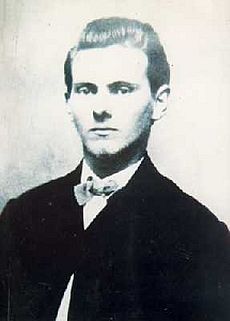Jesse James facts for kids
Quick facts for kids
Jesse James
|
|
|---|---|
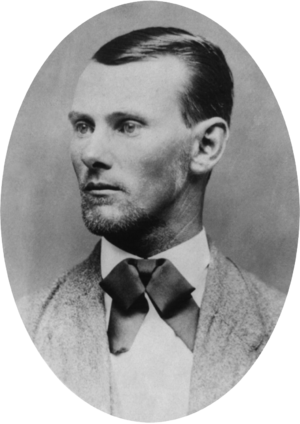
James c. 1882
|
|
| Born | September 5, 1847 Near Kearney, Missouri, U.S.
|
| Died | April 3, 1882 (aged 34) St. Joseph, Missouri, U.S.
|
| Cause of death | Gunshot wound to the head |
| Years active | 1866–1882 |
| Spouse(s) |
Zerelda Mimms
(m. 1874) |
| Children | 4, including Jesse E. James |
| Parents |
|
| Relatives | Frank James (brother) Wood Hite (cousin) |
| Signature | |
Jesse Woodson James (born September 5, 1847 – died April 3, 1882) was a famous American outlaw. He was known for robbing banks and trains. Jesse was also a guerrilla fighter during the American Civil War. He led a group called the James–Younger Gang.
Jesse grew up in Missouri, a state with strong Southern ties. He and his brother Frank James joined pro-Confederate fighters. These groups were called "bushwhackers." They fought in Missouri and Kansas during the Civil War. As followers of William Quantrill and "Bloody Bill" Anderson, they were accused of terrible acts. These acts were against Union soldiers and people who wanted to end slavery. One such event was the Centralia Massacre in 1864.
After the war, Jesse and Frank became part of outlaw gangs. They robbed banks, stagecoaches, and trains across the Midwest. They became very famous. Many people even felt sympathy for them, despite their violent crimes. The James brothers were most active from about 1866 to 1876. In 1876, they tried to rob a bank in Northfield, Minnesota. Many gang members were caught or killed.
Jesse and Frank continued their crimes for several more years. They found new members for their gang. But law enforcement was closing in. On April 3, 1882, Robert Ford shot and killed Jesse James. Ford was a new gang member. He hoped to get a reward for James's capture and a pardon for his own past crimes. Jesse James was already famous when he was alive. After his death, he became a legend of the Wild West.
Some stories say Jesse James was like Robin Hood. They claim he robbed from the rich and gave to the poor. But there is no proof that his gang shared their stolen money. Historians see James as one of many criminals. These criminals were inspired by former Confederates after the Civil War. He was not fighting for fairness or justice. Jesse James remains one of the most famous figures from that time. His life has been shown in many movies and stories.
Contents
Jesse James's Early Life
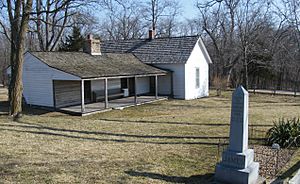
Jesse Woodson James was born on September 5, 1847. His birthplace was in Clay County, Missouri, near today's Kearney. This area was called "Little Dixie." Many people there came from Kentucky and Tennessee. Jesse had an older brother, Frank James, and a younger sister, Susan. His family had roots in England and Scotland.
His father, Robert S. James, grew hemp in Kentucky. He was also a Baptist minister. He moved to Missouri and helped start William Jewell College. Robert James owned six slaves and over 100 acres of farmland.
Jesse's father went to California during the Gold Rush. He wanted to preach to the gold seekers. He died there when Jesse was only three years old. After his father's death, Jesse's mother, Zerelda, remarried twice. First, she married Benjamin Simms in 1852. Then, in 1855, she married Dr. Reuben Samuel. He moved into the James family home.
Missouri During the Civil War
The American Civil War greatly affected the James–Samuel family. Missouri was a "border state." This meant it had traits of both the North and the South. Most of its people (75%) were from Southern states. Clay County, where Jesse lived, was very Southern in its culture. Farmers grew the same crops and raised the same animals as in the South. They also brought slaves with them.
Clay County had more slaveholders and slaves than most other parts of Missouri. In the whole state, only 10% of people were slaves. But in Clay County, 25% of the population were slaves. This Southern culture shaped how people acted during and after the war.
In 1854, the Kansas–Nebraska Act was passed. This law caused a lot of trouble in Clay County. People argued about whether slavery would spread into the nearby Kansas Territory. Many Missourians went to Kansas to try and influence its future. The violence between pro-slavery and anti-slavery groups on the Kansas–Missouri border was called "Bleeding Kansas." This violence was a big part of the lead-up to the Civil War.
Jesse James and the Civil War
After some big battles in 1861, guerrilla fighting took over Missouri. "Bushwhackers" who supported the South fought against Union forces. These Union forces were mostly local groups called "jayhawkers." This led to a harsh conflict. Both sides committed terrible acts. Confederate guerrillas killed Union supporters and prisoners. Union forces used martial law. They raided homes, arrested people, and sometimes executed them. They also forced Confederate supporters to leave the state.
The James–Samuel family sided with the Confederates. Frank James joined a local Confederate group. He fought at the Battle of Wilson's Creek in August 1861. He got sick and came home. In 1863, he was part of a guerrilla group in Clay County. In May 1863, Union soldiers raided the James–Samuel farm. They were looking for Frank's group.
Joining Quantrill's Raiders
Frank James escaped capture. He was believed to have joined William C. Quantrill's guerrilla group, Quantrill's Raiders. It is thought he took part in the terrible Lawrence Massacre. This event killed about two hundred men and boys in Lawrence, Kansas. Lawrence was a center for people who wanted to end slavery.
Frank followed Quantrill to Sherman, Texas, in the winter of 1863–1864. In the spring, he returned with a group led by Fletch Taylor. When they arrived in Clay County, 16-year-old Jesse James joined his brother in Taylor's group.
Taylor was badly hurt in the summer of 1864. He lost his right arm. The James brothers then joined the bushwhacker group led by William "Bloody Bill" Anderson.
Because of the James brothers' actions, Union military leaders forced their family to leave Clay County. They were told to move South, but instead, they moved North into Nebraska Territory.
"Bloody Bill" Anderson was killed in October. After this, the James brothers split up. Frank went with Quantrill to Kentucky. Jesse went to Texas with Archie Clement, one of Anderson's officers. Jesse returned to Missouri in the spring.
Life After the Civil War
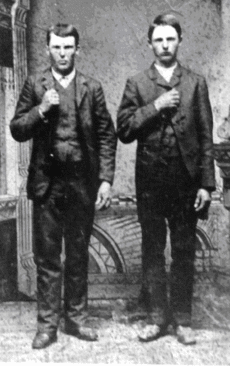
After the Civil War, Missouri was still very divided. The state's people were split into three groups. There were anti-slavery Unionists, who joined the Republican Party. There were also conservative Unionists who supported segregation and joined the Democratic Party. Finally, there were pro-slavery former Confederates. Many of them also joined the Democrats, especially in the southern part of the state.
The Republican-controlled government after the war passed a new state constitution. This constitution freed Missouri's slaves. It also stopped former Confederates from voting or serving on juries for a time. The situation was tense. There were many fights between people and armed groups from both sides of the war.
The James–Younger Gang's Crimes
The James brothers joined with Cole Younger and his brothers, John, Jim, and Bob. They also teamed up with Clell Miller and other former Confederates. Together, they formed the James–Younger Gang. Jesse James was the most well-known member of the gang. However, the group likely shared leadership.
The gang carried out many robberies. They robbed banks, stagecoaches, and even a fair in Kansas City. They often committed their crimes in front of crowds. Sometimes, they even put on a show for the people watching.
On July 21, 1873, they started robbing trains. They derailed a Rock Island Line train west of Adair, Iowa. They stole about $3,000. For this robbery, they wore Ku Klux Klan masks. At this time, the Klan had been stopped in the South. Former rebels attacked railroads because they saw them as symbols of a powerful central government.
The gang's later train robberies were less violent. They only robbed passengers twice. In other cases, they only took money from the express safe in the baggage car. A newspaper editor named John Newman Edwards helped create a "Robin Hood" image for James. He highlighted these less violent methods. But there is no proof that the James gang ever shared their stolen money with anyone outside their group.
Jesse married his cousin Zee on April 24, 1874. They had two children who lived to be adults: Jesse Edward James (born 1875) and Mary Susan James (born 1879). Their twins, Gould and Montgomery James (born 1878), died as babies. Jesse Jr. later became a lawyer in Missouri and California.
On September 7, 1876, the James–Younger gang tried to rob the First National Bank in Northfield, Minnesota. The robbery went very wrong. After it, only Frank and Jesse James were still alive and free.
With his gang almost destroyed, Jesse James only trusted the Ford brothers, Charley and Robert. Charley had been on raids with James before. Bob Ford was a new member who was very eager. For safety, James asked the Ford brothers to live with him and his family.
At this time, Bob Ford had secretly talked with Missouri Governor Thomas T. Crittenden. Ford planned to capture the famous outlaw. Governor Crittenden had made catching the James brothers his main goal. He said that nothing should stop them from facing justice. The law stopped him from offering a huge reward. So, he asked railroad and express companies to offer a $5,000 reward for each brother. They also offered another $5,000 for a conviction.
Jesse James's Death
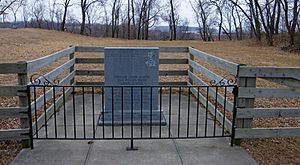
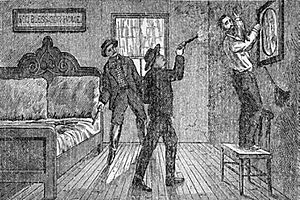
On April 3, 1882, Robert Ford shot and killed Jesse James.
Jesse James's death became a huge national story. The Fords did not try to hide what they had done. The Ford brothers gave themselves up to the police. They were surprised to be charged with first-degree murder. In just one day, the Ford brothers were charged, pleaded guilty, were sentenced to death by hanging, and then pardoned by Governor Crittenden.
The governor's quick pardon suggested he knew the brothers planned to kill James, not just capture him. This idea that Missouri's governor helped plan to kill a private citizen shocked the public. It also made Jesse James even more famous.
The Fords received only a small part of the reward. Then they left Missouri. Sheriff James Timberlake and Marshal Henry H. Craig were law enforcement officials involved in the plan. They received most of the reward money.
Jesse James was first buried on his family's land. Later, he was moved to a cemetery in Kearney. His original footstone is still there, but the family replaced the headstone. Jesse's mother, Zerelda Samuel, wrote this on his grave: "In Loving Memory of my Beloved Son, Murdered by a Traitor and Coward Whose Name is not Worthy to Appear Here." Jesse's wife, Zerelda Mimms James, died alone and poor.
Museums and Festivals About Jesse James
There are many museums and places dedicated to Jesse James:
- The James Farm in Kearney, Missouri: In 1974, Clay County bought this property. It is now a museum and historic site.
- The Jesse James Home Museum: This is the house where Jesse James was killed. It was moved several times and is now near Patee House. The Patee House was once the headquarters of the Pony Express.
- The Jesse James Bank Museum: This museum is in Liberty, Missouri. It is the site of the first daylight bank robbery in the United States during peacetime.
- First National Bank of Northfield: The Northfield Historical Society in Northfield, Minnesota, has restored this bank building. It was the scene of the 1876 robbery attempt.
- Heaton Bowman Funeral Home: This funeral home in St. Joseph, Missouri, did Jesse James's autopsy and funeral. A room there holds records from that time.
- The Jesse James Tavern: This tavern is in Asdee, County Kerry, Ireland. Some claim James's family came from this area. But records show his father's family was English and had been in America for generations.
- Mammoth Cave National Park: Some legends say Jesse James hid in parts of this cave system. He was also said to have robbed a stagecoach nearby. However, experts say these stories are likely not true. Many caves claim Jesse James visited them.
Festivals Celebrating Jesse James
The Defeat of Jesse James Days in Northfield, Minnesota, is a very large outdoor event. It happens every September. Thousands of visitors watch reenactments of the robbery. There is also a championship rodeo, a carnival, and a parade.
Jesse James's childhood home in Kearney, Missouri, is a museum. Each year, the Jesse James Festival is held there in September.
The Victorian Festival in Jersey County, Illinois, happens on Labor Day weekend. It is held at the 1866 Col. William H. Fulkerson estate. The festival tells Jesse James's story. It includes reenactments of stagecoach holdups. Thousands of people learn about the James Gang's visit to this area.
Russellville, Kentucky, was the site of a bank robbery in 1868. A reenactment of this robbery happens every year. It is part of the Logan County Tobacco and Heritage Festival.
The town of Oak Grove, Louisiana, also hosts an annual Jesse James Outlaw Roundup Festival. This festival usually takes place in the fall. It refers to a short time James supposedly spent near this area.
See also
 In Spanish: Jesse James para niños
In Spanish: Jesse James para niños


